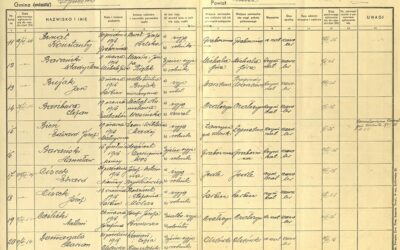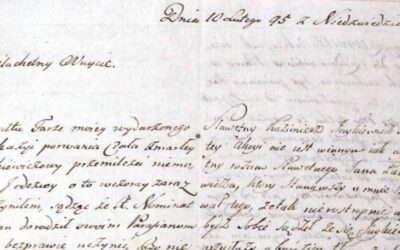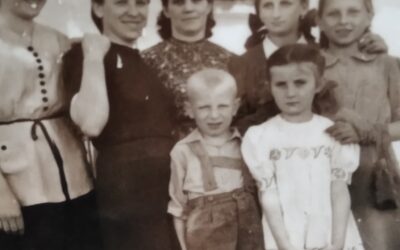Krzczonowski folk costume (“worn by the country people from the neighbourhood of the villages Krzczonów and Piotrków, situated south of Lublin”) based on the description of Janusz Świeży, the author of the book Atlas of Polish Folk Costumes (Atlas Polskich Strojów Ludowych).
In the east of Poland, among the green forests and fields painted with the colors of cereals and sunny oilseed rape, we can find Krzczonów – the former royal village. This is where the dress of the Lublin region has its source. Simultaneously it was also worn by the people of the nearby Piotrków.
According to an expert on the topic – Janusz Świeży, in his Atlas of Polish Folk Costumes the krzczonowski-piotrowski dress “is a clearly formed set of elements, that is separated from the neighbouring dress styles”.
The villages of Krzczonów, Piotrków and Chmiel were a part of the Polish crown land. The population of those regions had smaller duties than those in the other regions. The distinctness can also be seen in the partial settlement of strangers from foreign lands.
At the turn of the 19th and 20th century the dress has spread out to the entire Lublin region and has become it’s representative.
In 1934, a cutting and sewing course was organised in Krzczonów, during which the need to sew and wear folk dress was propagated. This event initiated the spread of the outfit to a much wider area. The knowledge of this outfit was further strengthened thanks to the band playing „Wesele Lubelskie”.
The “Wesele Krzczonowskie” [Krzczonów’s Wedding] – a film of Wojciech Siemion, born in Krzczonów was also of great importance.
The beginnings of the colorful outfit of Krzczonów occur, like many other outfits, during the industrial revolution. The availability of factory multi colored fabrics meant that the clothes became more decorative.
Men’s dress: “The men began to wear black trousers, vests, caftans, leather belts, decorated with brass balls „.

The skirts were sewn together with one coloured fabrics. They were decorated with colourful ribbons sewn in parallelly on the skirt. Colour contrasts were used. The ribbons were arranged ‘rhythmically’.
A short apron was worn over the skirt, sewn from a fabric in a different colour from the skirt, and it was also decorated with colourful ribbons called the vertical stripes. The garment is crowned with lace sewn to the edge of the apron.
Tight bodices or caftans/katanka were worn with wide skirts.

At the beginning of the 20th century, the so-called windows on women’s and men’s caftans were being cut in in Krzczonów. Colorful ribbons were woven into them. Such works were also introduced to men’s velvet belts. The original local embroidery was replaced with cross-stitch, which was introduced by the wife of one of the residents of Krzczonów, originally from Russia.
Stages of the Krzczonowski folk dress:
- The oldest period lasted until the end of the 1870s. It consisted entirely of linen, homespun cloth. In winter, brown coats and white sheepskin coats and sheepskin hats were worn. The woman’s clothing was also made of linen. They wore clogs, fur boots and woolen headscarves in winter.
- In the years 1870 to 1914, women’s costumes were made of colorful fabric materials purchased in the city and richly decorated.
- The time from World War I to around 1930 was a period of rapid decline of folk costumes in favor of cheap urban fashion. The general tendency to even out differences between the city and the village was also important.
- From the 1930s, there was some revival of the folk costume, but it only included festive attire.
The geographical scope of the Krzczonów community, covering the period to around 1950.
The cluster consists of: Olszanka, Żuków, Policzyzna, Lipniak, Pustelnik, Walentynów, Krzczonów, Majdan – Piotrkówek, Lewandowszczyna, Romanów, Zielona, Zaraszów, Władysławów, Urszulin, Kosarzew, Gierniak, and Borzęcinek. Whereas in the southern part of the Piotrków community, currently Jabłonna with the villages of Majdan Kozicki, Chmiel, Piotrków, Piotrkówek, as well as the eastern part of the Bychowa community, together with the villages of Ossowa, col. Ossowa, Gałęzów, and Wola Gałęzowska.
The description of women’s dress:
Headdress
At the end of the nineteenth century, the maids combed their hair with a parting in the middle of the head, braids braided from the sides. The left braid was placed on the right side of the head, just above the ear. Then it was turned and directed to the back of the head. The second right braid was tucked away. This arrangement was the foundation for the head costume called „the moon”, „horns” or „flowers”. The decoration of the braids consisted of red and white artificial roses, sequins, silver and gold threads, forget-me-nots and similar flowers. Ribbons flowed down the back from the flowers. This is how the heads were decorated until the end of WWI.
In the first half of the nineteenth century, the brides put on their head a small flat bonnet, its surface was covered with crinkled „trifles”, colored ribbons, plain or woven in flowers, arranged in several rows. To this bonnet, ribbons falling on the back down to the waist were also attached.
By the end of the 19th century, this headdress faded. In its place appears a wedding cap, or kerchief. It was made of red material, tight to the head. Red, cream and pink roses, lilies of the valley, light blue and leaves were pinned on it, as well as sequins set on wires and silver threads. It was decorated in such a way that the red material was completely covered.
The edge of the bonnet at the front was decorated alternately with red and green ribbons ruffled in the shape of a harmonica. From under these ribbons, 11 pendants fell on the hair, each consisting of 3 strings of glass beads. A bud of ribbons on the back of the cap fell on the back. The cap was tied under the chin with a red ribbon tied with a bow. In the 1950s, such head decoration disappeared completely.
A characteristic headgear for young married women was the ‘humelka’ dating back to the oldest traditions. At first it was covered with white cloth, later it was replaced with mesh lace. „Czepiec” was made on special looms in the Biłgoraj, Zamość and Krasnystaw poviats.

Such a mesh was pulled on the hoop „obiecaina” made of linden bark. Its edge was covered with a satin, green ribbon, below it a red one was placed.
Then the „obiecaina” was wrapped three times with a „cloth” or tape 3 cm wide, decorated with woven stripes in red, blue and white. The ribbons covered in this way became almost invisible, sliding only at the back. One end of the cloth was pushed up at the front and the other at the back.
The ends were covered with embroidery and lace. Gold and silver threads were attached to the back, with colorful sequins and beads gleaming at their ends. Underneath, embossed or embroidered ribbons fell on the back. So many of them were placed, that they covered the backs of the women until their waists. These ribbons were arranged so that the middle one was visible in its entirety, and the other ones would slide out from below on both sides in colorful pairs.
If there was an amaranth ribbon inside, then on both sides of it were lilac ribbons, then white and finally orange, blue and dark lilac. On the whole it consisted of 7-9 double ribbons, in 4-5 colors.
Married women heads were covered with a kerchief, also called „dupka”. The scarves were worn compulsorily, the women wore it all the time since the unveiling and capping ceremony.
The kerchief was tied in a kind of bonnet, surrounded by a roller, only the ends of the scarf called „the tail” fell on the back.
Widows, getting re-married, decorated their kerchiefs with tinsel, attached with colorful ribbons at the back. They put on a plain wool scarf tied under the chin over the kerchief. A tie of a kerchief protruded on the front of the head.
Women’s shirts
Until World War I, women’s shirts had a framed cut, and similarly to the men’s shirts, were sewn from rectangular pieces of linen canvas. Only in the armpits a squared patches called ‘wtoki’ were sewn. The shirts had rolled up collars called a „oszewka”, about 8 cm wide. Decorated with a lockstitch machine, and sometimes with white embroidery. The collar was tied under the neck with a red or green ribbon called a ‘feteczka’.
The cuffs were decorated with „balls”. This type of decoration was based on puckering the material with linen threads. The cuffs were decorated with „balls”. This type of decoration was based on removing the material with linen threads. Thanks to this, a 4-4.5 cm wide geometric ornament was obtained. A 7-8 cm wide frill, covering the fingers, flowed down from the decorative cuff, decorated with white embroidery. The cuffs were tied with a ‘feteczka’, the same as at the neck.
The shirt was decorated with a stitch called „cyra„. Frames with the front and back of the shirt were connected in this way. Sometimes lockstitch ran parallel to the cyra.
If the shirts were sewn without the framed cut, they were decorated with ‘ciskanka’. The cut on the front was decorated with a triple or double lockstitch. At the bottom, they were decorated with „obrzucka”. Circus, tzipes, lockstitch and obrzucki were made with white thread, which was reflected on the gray background of the shirt.
Later, the ball decorations and the frill at the border disappear.
White embroidery remains dominant, but next to it there are red, blue and yellow decorations. In the post-war years, cross-stitching spreads.
The skirt
Until the 1870s, women wore linen skirts called „aprons”, they were „trified” meaning that they were crinkled into small pleats.
In the second half of the nineteenth century, skirts sewn from matt wool appeared, five skins were allocated for one skirt, skirts reached to the ankles, calm colors dominated, never vivid. Most often blue, red (beetroot), green. Skirts creased at the waist fell in folds. Skirts were decorated with ribbons, strings arranged in stripes on the background of the skirt. The most commonly used ribbon colours were: light-blue, pink, green, light and dark-yellow, white and also a ribbon with a woven rooster motif.

The ribbons were separated with ribbons. The skirt straps consisted of 10 to 18 ribbons and strings surrounding the skirts at knee height. Oftentimes, lace was sewn in the middle of these stripes.


At the bottom, the skirt was trimmed with a velvet or woolen belt of dark color, 7 to 15 cm wide. Such a belt was called ‘podmurówka’ or foundation. The edge was trimmed with a red brush. The upper edge of the foundation was often decorated with ribbons or strings.
The bride’s skirt was long in white or cream. It had a 11 cm wide lace sewn on at the knee height. At the bottom it was sewn with a white silk ribbon decorated with flowers.
Apron
An apron called a ‘zapaska’ was put on the skirts, and it covered the fly of the skirt. Originally there were no decorations on it, usually it reached below the knees, and was about 66cm long.
At the end of the 19th century an apron appeared, short, colorful different in color to the skirt. Its length was about 30 cm, sewn from about 2 to 2.5 meters of material. Strongly creased it surrounded the whole figure. Those aprons were sewn in the following colors: black, green, orange and pink. The bottom edge was decorated with black or white lace. On the apron, similarly to the skirt, rows of ribbons were sewn. In no case, however, did the apron cover the skirt. In the interwar years aprons reaching below the knees appeared.

The bride’s apron was long, reaching below the knees, two or three white satin ribbons were sewn in the center, and white lace trimmed at the bottom.
Corset
The first corsets for the Krzczonowski outfit appeared around 1870. They were sewn from black velvet and laced at the front with red and green wrinkled ribbon. The front was decorated with several rows of red and green ribbons. Flaps dropped from the waist in an amount of 15 pieces and were trimmed with wrinkled ribbons.
Over time, the wrinkled ribbons were replaced with plain ones. At the waist and along the cut, the corset was sewn with a wide white ribbon or orange with rooster motif. Corsets, in addition to flaps, were trimmed with a red brush. In addition to black corsets, one could also find them in the cherry, dark green and purple colors.
At the turn of the 19th and 20th centuries, many corsets were sewn with gold and silver stitch, also interwoven with sequins of the same color.
The wedding corset was white, silk decorated with silver and gold thread and also sequins in the same colors.
Caftan / Katanka
Women wore shirts with sleeves or „caftans” on blouses. At first, they were white caftans with narrow sleeves. They were fastened with yellow or red buttons. On both sides of the fastener and also on the cuffs, there was a red and green chain lockstitch ornament.

In the 1870s red and green caftans of fine wool appeared. Rows of ribbons and strings replaced earlier decorations.

Footwear
Initially, women wore yellow and black leather clogs. In the 1870s, footwear called „Ciżemki” made of black leather appeared.
Outfit accessories
Women wore real beads, later glass beads also appeared.
I hope that the story and description of the outfit will reach more people. I tried to write it, keeping my original vocabulary so as not to lose valuable details.
The Krzczonowski folk dress deserves to be remembered so that we could proudly represent it at ceremonies in Poland and abroad.
It is a beautiful showcase of Polish traditional culture, let’s keep this souvenir for as long as possible.
Special thanks for the support for Mr. Wojciech Cioczek, a resident of Krzczonów who enthusiastically promotes local traditions.
Polish Version https://genealogicznapodroz.com/2019/04/01/stroj-krzczonowski/
Krzczonów wieś królewska- ocalić od zapomnienia
Inisowiacy Polish Folk Groupe
Polish Folk Style Polski Folk w Irlandii
Author:
Ania B-M
Translation Polish to English: Kamila O.
information from:
Atlas Polskich Strojów Ludowych – Janusz Świeży
Kilka słów o mieszkańcach parafii Krzczonów – Władysław Koźmian, Wisła 1902, t XVI strona 309



0 komentarzy